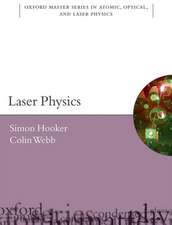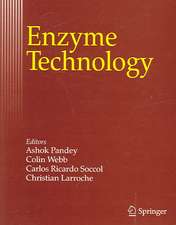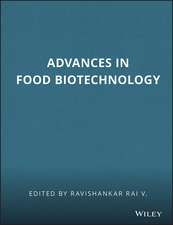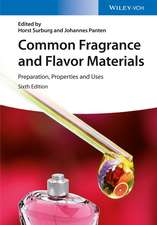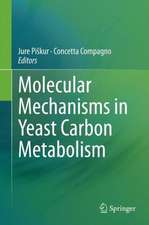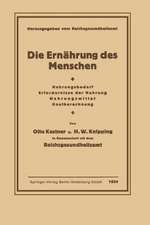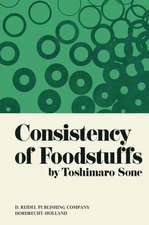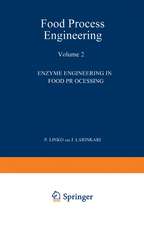Cereals: Novel Uses and Processes
Editat de Grant M. Campbell, Colin Webb, Stephen L. McKeeen Limba Engleză Hardback – 30 mar 1997
| Toate formatele și edițiile | Preț | Express |
|---|---|---|
| Paperback (1) | 943.22 lei 6-8 săpt. | |
| Springer Us – 28 oct 2010 | 943.22 lei 6-8 săpt. | |
| Hardback (1) | 956.69 lei 6-8 săpt. | |
| Springer Us – 30 mar 1997 | 956.69 lei 6-8 săpt. |
Preț: 956.69 lei
Preț vechi: 1166.69 lei
-18% Nou
Puncte Express: 1435
Preț estimativ în valută:
183.06€ • 191.13$ • 151.51£
183.06€ • 191.13$ • 151.51£
Carte tipărită la comandă
Livrare economică 04-18 aprilie
Preluare comenzi: 021 569.72.76
Specificații
ISBN-13: 9780306455834
ISBN-10: 0306455838
Pagini: 290
Ilustrații: XVIII, 290 p.
Dimensiuni: 178 x 254 x 19 mm
Greutate: 0.77 kg
Ediția:1997
Editura: Springer Us
Colecția Springer
Locul publicării:New York, NY, United States
ISBN-10: 0306455838
Pagini: 290
Ilustrații: XVIII, 290 p.
Dimensiuni: 178 x 254 x 19 mm
Greutate: 0.77 kg
Ediția:1997
Editura: Springer Us
Colecția Springer
Locul publicării:New York, NY, United States
Public țintă
ResearchDescriere
"So long as a person is capable of self renewal they are a living being. " -Amiel Cereals have been the source of life to the human race, providing nutritional and ma terial needs since the dawn of civilization. As with all dynamic industries, the Cereal in dustry has renewed itself in the past; as the millennium approaches, it is on the brink of another renewal, in which the versatility and providence of cereals are being rediscovered, but in new and exciting ways. Cereals are richly diverse; over 10,000 varieties convert minerals and the energy of the sun into a bursting catalog of functional and versatile biomolecules and biopolymers. Processing technology allows these components to be accessed, separated, isolated and purified, while chemical science allows modification for even greater diversity and speci ficity. The last century has seen the move from cereal- to oil-based chemical and materials industries. But cereals contain a greater variety and functionality of macromolecules than oil. Starch, protein, bran and straw, already diverse across cereal varieties, can be fraction ated into more specific elements, modified chemically to enhance function, or used as feedstocks in fermentation-based bioconversion systems, to produce a range of bulk and fine chemicals for industries as diverse as food, pharmaceuticals, plastics, textiles, pulp and paper, transport, composites and boards, adhesives and energy.
Cuprins
Cereal Components. The Potential of Cereals as Industrial Raw Materials: Legal, Technical and Commercial Considerations; J. Coombs, K. Hall. Starches. Present and Future Uses of Cereal Starches; D. Howling. Industrial Markets for UK-Grown Cereal Starch; S.E. Batchelor, et al. Plastics and Chemicals. Flexible Polyurethane Foam Extended with Corn Starch; Y. Lin, et al. Biodegradable Composites of Starch and Poly(hydroxybutyrate-co-valerate) Copolymers; J.L. Wilett, G.S. O¿Brien. Biodegradable Coatings for Thermoplastic Starch; J.W. Lawton. Properties of Starches, New and Old. Cereal Starches: Properties in Relation to Industrial Uses; A. Lynn, et al. Proteins. Application of Cereal Proteins in Technical Applications; P. Kolster, et al. Bran and Straw. On-Line Measurement of Bran in Flour by Image Analysis; M.B. Whitworth. Whole Crop Utilization: Integrated Bioprocesses. Food and Non-Food Uses of Immature Cereals; R. Carlsson. Fermentation: The Key Technology. Development of a Generic Fermentation Feedstock from Whole Wheat Flour; C. Webb, R. Wang. Food Processes. Functional Foods for Health: Opportunities for Novel Cereal Processes and Products; P. Wood. 21 Additional Articles. Index.

